Yesterday And Today
Doug Dillard: An Appreciation
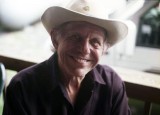
Doug Dillard (1937-2012): Farewell to Jebbin Darling
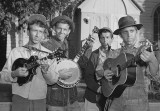
Dillard (second from left) with the Darling Boys on “The Andy Griffith Show”
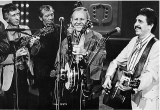
The original Dillards, 1967
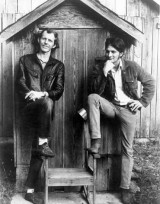
Dillard and Gene Clark
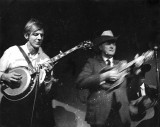
Doug Dillard and Bill Monroe
There’s a cliche about famous deaths always coming in a group of three. One of the more recent trios of musician-related deaths caused many readers to look up from the obituary page to take time to pause and reflect. Earl Scruggs (who died on March 28), Doug Dillard (May 16), and Doc Watson (May 24) all knew and respected one another; Scruggs and Dillard were virtuoso banjo players and Watson was a flat pick guitarist of the highest order. Each one revolutionized county and bluegrass music with their respective instruments.
Of the three, Doug Dillard was perhaps the most eclectic of the trio, with a career that spanned the music of his native Ozarks to the pioneering West Coast country rock of the ’60s and ’70s. There was also a stopover during the early ’60s in America’s favorite mythical hometown of Mayberry, North Carolina.
From his informative biography page on his website (penned by writer Lynne Robin Green), Douglas Flint Dillard was born on March 6, 1937 in Salem, Missouri, the second son of Homer and Lorene Dillard. It was a typical small town in the Ozarks and has remained very much so, with a population today hovering around 5,000. Similar to Ike Everly and his talented offspring, Phil and Don, the Dillard family were a family band whose main connection with the greater world — the living room radio — kept them abreast of the rising talent. Whether it was a church social, pie supper, or a square dance night, Salem was accustomed to seeing the Dillard family lineup of Homer on fiddle, Lorene on guitar, and Earl (their oldest child) on piano. The precocious younger members of the family, Doug and Rodney, were not the least bit shy about taking the stage and jumping in. It was a common sight to see a young Doug playing around the streets of Salem with Bill Glenn, another rural music enthusiast who would end up being one of Doug’s closest friends. While his earliest musical memories might be when he began to play guitar at age five, Doug heard Scruggs as a teenager and was never the same — it was goodbye guitar, hello banjo. “I was driving down the road with the radio on,” Doug recalled. “All of a sudden I heard this incredible banjo music. I got so excited that I drove off the road and down into a ditch. I had to be towed out.”
Doug, then 15 years old, composed a letter to his idol. When he asked Scruggs whether 16 was “too young” to tackle the banjo, the virtuoso assured him it was not and wrote Doug an inspiring note to pursue his dream. It wouldn’t be long before Doug would meet his idol in person. With a look of determination in his eyes, Doug talked his folks into making a 500-mile trip to the Scruggs’ home in Madison, Tennessee. Scruggs not only invited Doug in but installed the “Scruggs Tuners” on the lad’s banjo. In the decades to come, it became common for banjo enthusiasts around the world to acknowledge the names of Earl Scruggs and Doug Dillard in the same sentence.
Once he made the transition over to banjo, Doug played every radio and television music show he could find in middle America. From his website bio, there is documentation of his appearance on the Howe Teague program over KSMO in Salem. For three years (1956-59) Doug and his brother Rodney toured as the Ozark Mountain Boys, a group that also featured Bill Glenn, Henry and Jim Lewis, and Paul Breidenbach. One KSMO disc jockey in particular championed the cause of the Ozark Mountain Boys. Mitch Jayne, who was the voice behind the microphone on the Saturday morning music program “Hickory Hollow,” provided a showcase for the group at KSMO. Jayne was also a musician of local renown and he was later to join the Dillards full time. The transition to TV went smoothly and Doug appeared on the new medium as a member of Lee Mace and the Grand Ozark Opry.
The early ’60s found American college students embracing a wide variety of folk music, from the clean-cut, non-confrontational approach of the Kingston Trio to the more socially conscious material of the Greenwich Village community. The Dillards found an opening for bluegrass in the hallowed halls of academia, and a concert taped in 1962 at Washington University in St. Louis captured the student body clearly yelling out their approval. Having accomplished their mission in the Midwest, Doug and Rodney headed to Los Angeles. It was more than the Dillard brothers; it was a road-tested unit featuring Jayne on bass and Dean Webb on mandolin.
In hindsight 50 years later, the good fortune that fell upon Doug, Rodney, Mitch, and Dean now appears to be the dreams of which future Lana-Turners-discovered-at-Schwab’s-sipping-sodas are made of. But it is historical fact that the first week the financially strapped band arrived in Los Angeles, they caused a buzz around the city when they were invited to join the stage of the Ash Grove nightclub and played with the Greenbriar Boys. Impressed by both their musicianship and comedic timing was Jim Dickson, a recording industry executive who played a pivotal role in the success of the Byrds. Dickson immediately signed the band to Elektra, and in less than seven days, the group was embraced by local music fans. Also entertained by the Dillards’ stage charisma was producer Richard Linke of “The Andy Griffith Show,” who visualized the quartet as recurring fictional characters known as the Darlings.
The Dillards did for bluegrass music what Ricky Nelson had done earlier in the ’50s for West Coast rockabilly. During their six episodes on “The Andy Griffith Show,” the Darlings were portrayed by the Dillards as dim light bulbs who never spoke (try to picture a less creepy version of Deliverance) but were extraordinary musicians. Griffith — no neophyte picker himself — found instant camaraderie with the Dillards and the musical moments in each episode they appeared is why “The Andy Griffith Show” continues to delight audiences decades after its run. In the original script, Doug was given the name of Jebbin Darling but in subsequent episodes the Darling brothers were usually referred by Sheriff Andy Taylor (Griffith) as “the boys.” Character actor Denver Pyle portrayed Darling patriarch Briscoe Darling and actress Maggie Peterson was cast as the flirtatious Darling daughter, Charlene. (Over the years, Peterson has resurrected her character at Mayberry-themed concerts with several Dillard band members sharing the stage with her.)
Coinciding with their portrayal of the Darlings, the Dillards released their first Elektra LP, Back Porch Bluegrass. Between television shows, concerts, and long studio hours, Doug and Rodney created a side project “supergroup” called the Folkswingers, combining their talents with “Wrecking Crew” guitar ace Glen Campbell (see Troubadour, February 2012 issue) and dobro wizard Tut Taylor. The Folkswingers’ recorded legacy can be found in the two long players they recorded for the World Pacific label.
Continuing to grow in the open musical environment of Los Angeles, the Dillards followed the lead of the Byrds (comprised of former acoustic folk musicians themselves) by amplifying their sound and embracing the folk rock movement. Fortunately for the Dillards, it never got as confrontational as when Bob Dylan pumped up the volume at the Newport Folk Festival in 1965. Arthur Penn’s Bonnie and Clyde was one of the most discussed films of 1967 and audiences heard the distinctive bluegrass of Doug and Rodney while Warren Beatty and Faye Dunaway attempted to stay one step ahead of the law. The late ’60s showed the Dillards at their creative zenith. Doug left the Dillards in 1967 and was replaced by Herb Pedersen. The Dillards recorded two brilliant discs, Wheatstraw Suite and Copperfields. In the same era, Doug teamed up with ex-Byrd Gene Clark on the duo’s two A&M LPs The Fantastic Expedition of Dillard and Clark and Through the Morning, Through the Night. Guitarist Bernie Leadon (Flying Burrito Brothers and the Eagles), bassist David Jackson, and Donna Washburn comprised a solid backing unit for Dillard and Clark. Guest musicians included Chris Hillman and Michael Clarke of the Byrds and Flying Burrito Brothers fame.
The next four decades found Doug reuniting with the Dillards, participating in Mayberry reunions and contributing to more film soundtracks (Vanishing Point, The Rose, and Popeye). He continued to perform until declining heath sidelined him and he died from a lung infection last spring. Reaction from the music community was large and heartfelt. Steve Martin released the following statement, “Doug Dillard was a banjo icon. He, along with his group, the Dillards, influenced so many players…. He was a fast, clean, and a melodic player with his own style.” Chris Hillman told the Los Angeles Times that he would “put [Dillard] at the very top level of proficiency on the banjo, right up there with Earl Scruggs. He was a great musician, and he greatly influenced me.” Folk singer Bob Lind (see Troubadour, May 2012 issue), who played San Diego shortly after Doug’s death, shared his thoughts on his Facebook page. “During a lifetime you make maybe seven or eight real friends — friends you can go for years without seeing, then pick up right where you left off. Doug was that kind of friend. It’s no exaggeration to say it feels like an important part of my past has just been amputated. It’s not only my loss, but a loss to the music world as well. If you’ve never heard the magic of his banjo, please YouTube Doug Dillard. He leaves a powerful legacy.”
Local reaction to Doug’s passing brought out fond memories. Singer-songwriter Gary Ráchac recalled seeing Doug in the late ’60s. “The Dillards played the Candy Company in La Mesa in 1968 shortly after the release of their album Wheatstraw Suite. Doug had just left the group and was replaced by Herb Pedersen. Rodney took the small stage that night as front man donned in T-shirt, denims, and blue canvas deck shoes doing the introductions and singing lead on a lot of the songs; “Single Saddle,” “I’ve Just Seen a Face,” “The Biggest Whatever,” and “Listen to the Sound” were just a few they did that night from the new album during their two sets. They also included tunes from their “Back Porch” era such as “Dooley” and “Doug’s Tune.” I half- way expected Denver Pyle to walk through the door!”
Ráchac said Dillard and Clark “hit the stage at the Candy Company about a year later to promote the release of their A&M debut album — with full band consisting of drums, second guitar, bass, and back up (female) vocals. Contrary to popular belief, Bernie Leadon did not join the Expedition that fateful night in La Mesa. Dillard and Clark performed the entire first album, complete with “Don’t Come Rollin,’” “Out on the Side,” and “Train Leaves Here This Morning.” They were also doing some electric-flavored bluegrass instrumentals, and Gene was doing lead solos on “Set You Free This Time” and at least one other Byrds-era tune.”
The final word on Doug comes from Troubadour contributing Writer Lou Curtiss. Curtiss reflected on Doug’s musical prowess and his exuberant sense of humor. “The first time I had any close connection with Doug Dillard was at the first San Diego State Folk Festival back in 1967,” said Curtiss. “Before that I’d seen them play at the Ash Grove in LA, the Newport Folk Festival, and, of course, on TV with “The Andy Griffith Show.” As a record collector I had at least the first three LPs on Elektra (the ones with Doug). But in 1967 Ed Pearl, who owned LA’s Ash Grove, wanted to help give us a start in doing these festivals and he helped us get Bill Monroe and the Bluegrass Boys for a special lead off Thursday night. Well, it just so happened that due to high winds in the Lagunas, Bill’s band got stuck over in Imperial Valley with the highway over the mountains being closed. So we had a band and that consisted of Bill and his guitar player and, to our surprise, Doug Dillard, Dean Webb, and Mitch Jayne of the Dillards to kick off the first Folk Festival in a series that lasted awhile here in San Diego.
“Bill liked to put young pickers through their paces and one way he did that was to jump away from the mike after a vocal causing the person doing the break to bust their butt getting in place and keeping the beat of the song; Bill [all the while] knowing that most folks considered him a legend and one they didn’t want to offend by doing wrong. Doug knew what was coming and was ready for Bill to show that he owed these old Missouri boys a bit of respect as well. After Doug’s banjo break he scooted away from the mike, leaving Bill to do the hustling. Bill managed with a scowl on his face, which was returned by that everlasting Doug Dillard grin. He’d put one over on the Father of Bluegrass and gained a little respect from the legend.”
As for Doug’s legacy, Curtiss said, “The Dillards led off the bluegrass revival here on the West Coast, getting a head start over even Flatt and Scruggs in their popularity here in Southern California. When Doug left the band it became a forerunner of the whole folk rock scene while Doug stayed with bluegrass a little longer before moving on into that scene himself. In spite of his departing the bluegrass scene pretty early in the game, Doug remained long enough to become a legend himself, while at the same time becoming an early legend of a new kind of music that blended his roots with the sounds of rock that he heard around him in LA.”






